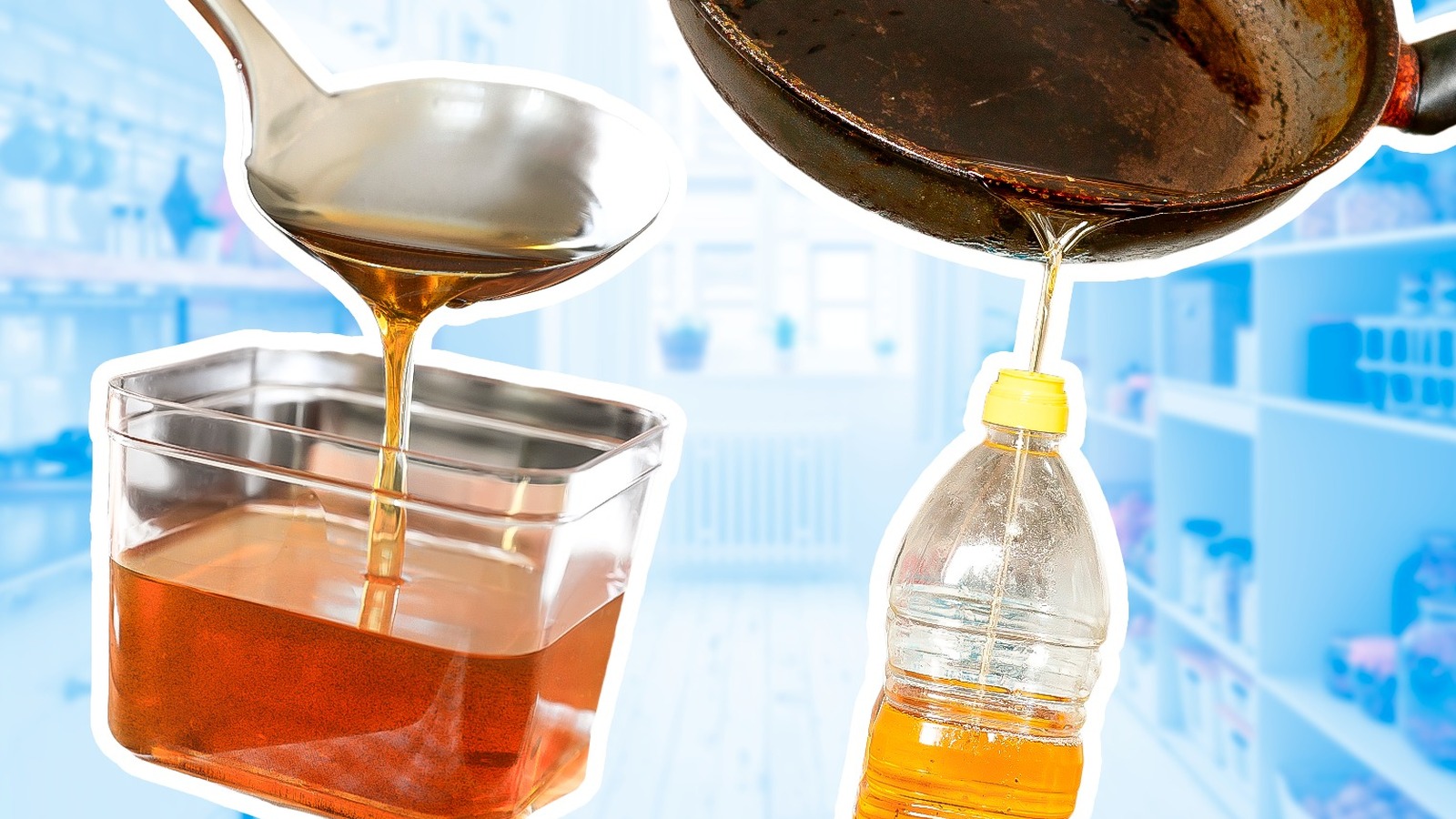In the realm of culinary creativity, the joy of preparing delicious meals and snacks often comes hand in hand with the all too familiar challenge of cleanup — specifically, dealing with used cooking oils. Responsible home cooks are constantly faced with the dilemma of finding eco-friendly, convenient, and safe ways to dispose of these oils without harming the environment or damaging important kitchen appliances and tools. Improper disposal of used cooking oils can have environmental consequences such as water pollution and harm to wildlife, and at home, pouring used oil down your kitchen drain can lead to clogs that require time and money to repair.
Fortunately, there are some remarkably simple and effective methods to handle used cooking oils in the comfort of your home. From various methods of solidifying oil before tossing it in the trash to finding places that are willing to take your old oil or even opting for disposable containers, these are some of the best ways to bid farewell to your cooking oils responsibly, ensuring a cleaner kitchen and a greener planet.
Contain oil with foil

When it comes to making kitchen cleanup more enjoyable and less of a hassle, a particularly helpful method involves the use of aluminum foil to cool and contain used cooking oils before disposal in a trash can. The aluminum foil hack for discarding grease involves forming a bowl-shaped receptacle where you’ll pour your oil. Allowing the hot oil to cool a bit can help protect the walls of your garbage can, and the foil allows you to quickly and efficiently remove the oil from pots and pans before you scrub them in the sink.
To start, line a bowl, or your sink drain with a sheet or two of aluminum foil. The foil acts as a protective barrier, preventing direct contact between the oil and your kitchen surfaces and ensuring easy and manageable cleanup. Then, gently pour the used cooking oil onto the foil-lined surface. Let the oil sit undisturbed until it solidifies. Once the oil has solidified, ball up the foil around it to create a compact and easily disposable package. Simply toss the solid foil-wrapped oil into the trash, and you’re done.
Chill the oil in the fridge

Don’t have aluminum foil on hand? No problem. Chilling grease in the fridge is another quick and accessible solution for disposing of used cooking oil after your next weekday dinner. This method not only provides a swift solution for oil disposal but also minimizes the risk of spills and simplifies your overall kitchen cleanup routine.
Begin by selecting a suitable container, perhaps an old soup can or a coffee mug, to contain the used oil. From there, pour the oil into the container and place it in the refrigerator. Allow the oil to rest undisturbed in the cold of the fridge until it solidifies. The lower temperature of the fridge interior expedites this process, turning the liquid oil into a more manageable, solid state. Grab the container from the fridge and use a spoon to dump the solid oil into the trash can before moving on to your next cleanup task.
Freeze oil for later use
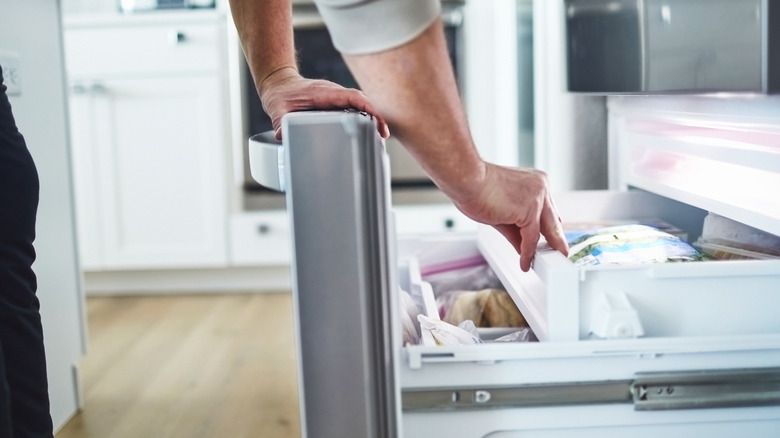
Whether you simply want to dispose of your used cooking oil after frying chicken for Sunday dinner or want to reuse it again for frying tomorrow morning’s breakfast, freezing used oil can be a practical and environmentally conscious approach to managing waste and getting a hand on kitchen cleanup.
Whatever you choose to do with your used cooking oil, the chilling method for preserving cooking oil is quick and easy — let the grease cool down a bit before pouring it into a container and placing it in the freezer. If you’re planning on tossing, use a disposable container before freezing and throw it directly into the trash once the oil is solid. If you want to reuse the cooking oil for a future dish, be sure to strain it to remove any floating food particles and store it in the freezer for up to three to four weeks. If you go this route, remember to use an airtight container to keep things fresh.
Empty oil into a disposable container

Marian Weyo/Shutterstock
For those occasions when time is of the essence, using a disposable container to throw away used cooking oil offers another convenient option that you can take advantage of with common items you likely have on hand already. This method is especially practical when you find yourself short on time but unwilling to compromise on responsible waste management.
Start by finding a disposable container readily available in your home. Whether it’s a takeout box from last night’s dinner or an empty milk jug, repurposing these items serves as an efficient and eco-friendly solution for disposing of grease easily. With your chosen container in hand, carefully pour the used cooking oil into it. The disposable nature of the container ensures a one-time use, preventing the need for extensive cleanup. Ensure the container is securely closed to avoid any potential leaks or spills in the garbage can. Once the oil is safely stored in the disposable container, it’s ready for the trash. Simply toss the sealed container into the garbage bin. Out of sight, out of mind.
Cool and scrape oil into the trash straight from the pan
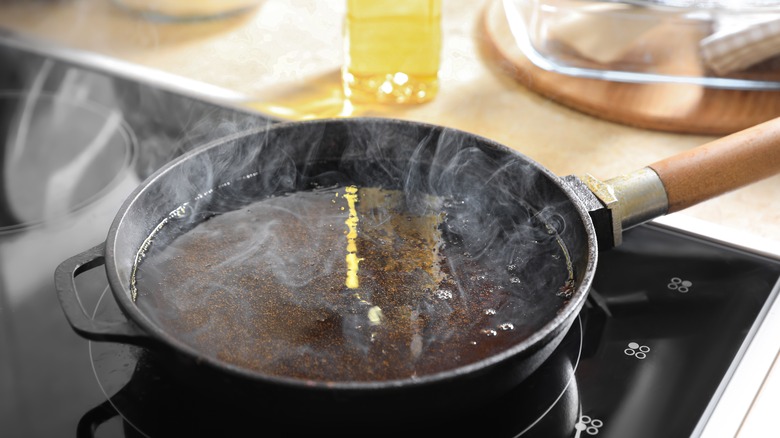
In situations where disposable containers are unavailable for freezing or chilling used cooking oil, a practical alternative to streamline your kitchen cleanup involves allowing the oil to naturally solidify in the pan directly after cooking. This simple yet effective method eliminates the need for additional containers or other tools like paper towels for soaking. The solidified oil can be easily scraped directly into the garbage can without leaks.
By taking advantage of the natural solidification process at room temperature, this approach helps minimize the mess and hassle associated with disposing of hot liquid cooking oil. Per National Geographic, in some circumstances, additional types of fat can be added while the used cooking oil is still warm. Doing so serves an additional purpose of congealing your used oil. Cooking oil will bond with certain types of hydrogenated oils and coagulate as they cool down further, allowing you to scrape off something closer to a “wobbly-but-solid disc” rather than viscous oil.
Not only does this cleanup method offer a convenient solution for those without disposable containers, but it also promotes a more efficient and sustainable approach to managing kitchen waste. No glass, aluminum, or plastic containers are needed to trap oil. The strategy embraces the principles of both simplicity and resourcefulness, providing an easy and quick way to dispose of used cooking oil without compromising on cleanliness and keeping environmental responsibility in mind.
Use paper towels to soak up the cooled oil
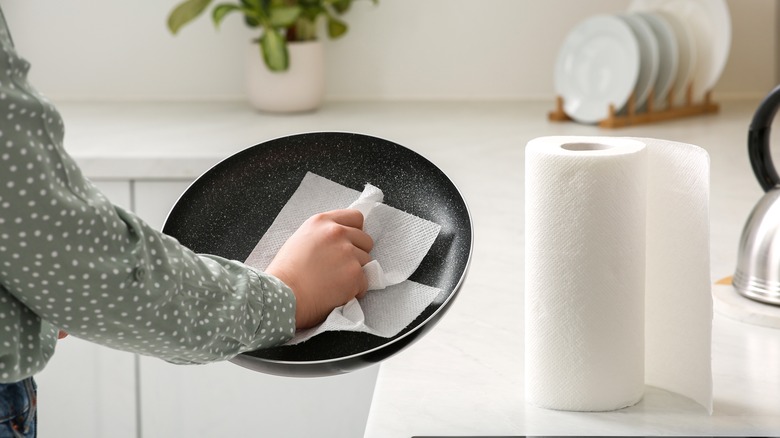
When dealing with leftover used cooking oil at the bottom of your pan, an effective and convenient method is to use paper towels for absorption and then dispose of the cooking oil in the trash can. Chances are that you’ve got this kitchen tool on hand, so it is an easy way to clean up your cooking oil in a quick and mess-free fashion.
To use this method, follow Martha Stewart’s method of disposing of cooking oil. Let the oil cool first, then place a few layers of absorbent paper towels on the slightly cooled oil and gently press down to soak up any residual liquid. (Be sure the oil is not too hot to avoid burning yourself while handling.) It does require quite a few paper towels, and another downside is that paper towels will still leave behind a slick residue that needs extensive scrubbing with dish soap. With that in mind, this method is by far one of the easiest to implement. It not only aids in fairly efficient cleanup but also prevents potential spills or leaks when moving the oil into the trash.
Soak up used oil with starch or acid
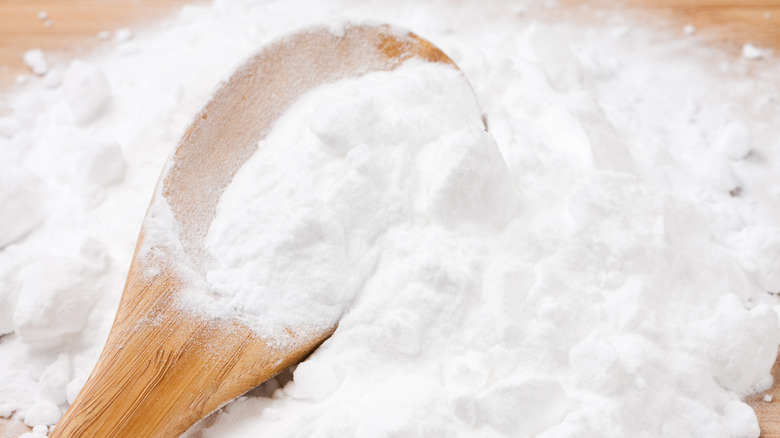
When it comes to wrapping up your culinary adventures and facing the challenge of cooking oil cleanup, there’s another laid-back trick in the pantry playbook. As with the paper towel method, another convenient way to clean and dispose of used cooking oil is to employ starchy ingredients commonly found in your pantry.
Common ingredients like flour and cornstarch can be used for cleaning spilled oil, as they are incredibly absorbent and can pack a powerful punch when cleaning up leftover oil in your pan. Another pantry staple you can reach for is baking soda, which has the same absorbent qualities as other starches, allowing it to bond together with fats and suck up the oil. Simply sprinkle a handful of the powder of your choice onto the oil and let sit for a few minutes. Once the powdered ingredients have done their job and absorbed all of the lingering greases in your pan, you can scuff off the pasty remnants with a spoon or paper towel and into the garbage can.
Continuing along this line, National Geographic also mentions a product known as stearic acid as an additional method for soaking up used oil. Stearic acid comes in a flaky form — it is less powdery than starches — but also works through basic principles of chemistry. The dry flakes are spread onto hot oil to bond, where they then congeal rather than become pasty. From there, it’s a simple dump in the trash.
Clean and reuse used oil for future cooking
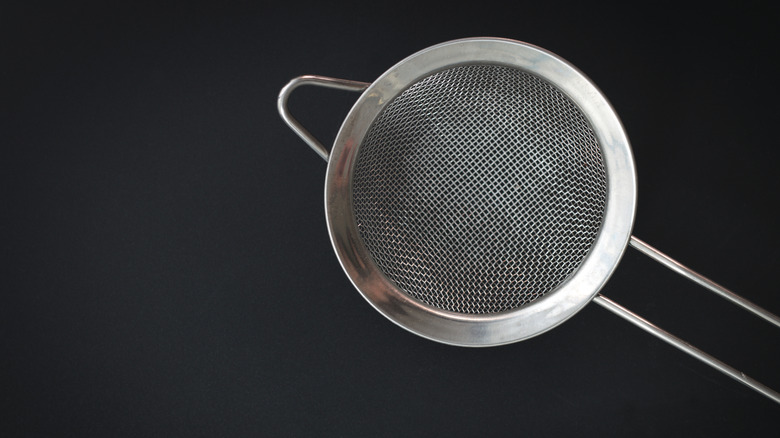
Finding ways to reuse and recycle kitchen waste allows you to get the most out of your ingredients — and it applies to your used cooking oil. Why throw away perfectly good oil when you can give it a second life? All you need to get started is a small kitchen strainer and coffee filter.
To clean your used oil prior to storing it, cut a piece of coffee filter to fit your strainer. Hold the strainer above a container, slowly pour the oil through the filter, and watch the solid bits and impurities stay behind as clean oil drips through.
Another creative method is to use the gelatin trick for cleaning used oil. This process utilizes a protein present in the connective tissues of animals to bond with the oil. By combining the gelatin with hot water, a gel-like substance is created that incorporates collagen molecules capable of capturing impurities in the frying oil, facilitating removal.
The process of this method is simple. Allow the hot oil to cool slightly while heating up approximately ½ cup of water in a separate pot. Once simmering, add about 1 teaspoon of plain, unflavored gelatin to the water until it’s dissolved, and then add the mixture to the oil. Place the mixture into the fridge overnight. In the morning, discard the disc of gelatin at the top of the pan before pouring the clean oil into your desired container for storage.
Repurpose gently used oil into a DIY project
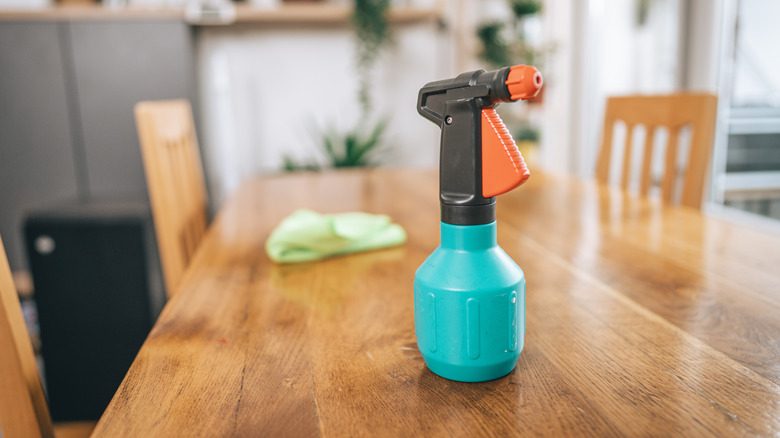
Are you feeling creative? There are countless ways to put your used oil to use once you’ve finished frying chicken or vegetables, some of which don’t even involve cooking. With a bit of thoughtfulness, you can turn your used cooking oil into a practical DIY project for your home that can help you get the most out of the ingredient and extend its life even more. Try recycling your used oil into projects like homemade furniture polish or leather conditioner. You can also turn gently used oil into grease for that creaky door hinge or repurpose oil from more intense uses into a savory food-scented candle.
Before you get started with whatever project you choose, be sure to clean the oil with a strainer to remove any food particles that might linger after cooking, and always work with cooled oil to prevent painful burns. Because any unpleasant odors may stick around in the oil’s new life as a DIY cleaning product or seasoning agent, it’s best to stick to the oil used for cooking or frying light foods, such as vegetables. For projects centered around solidified oil, turn again to stearic acid, which will solidify your leftover cooking oil and give it new life.
Toss the cooled oil in your compost pile
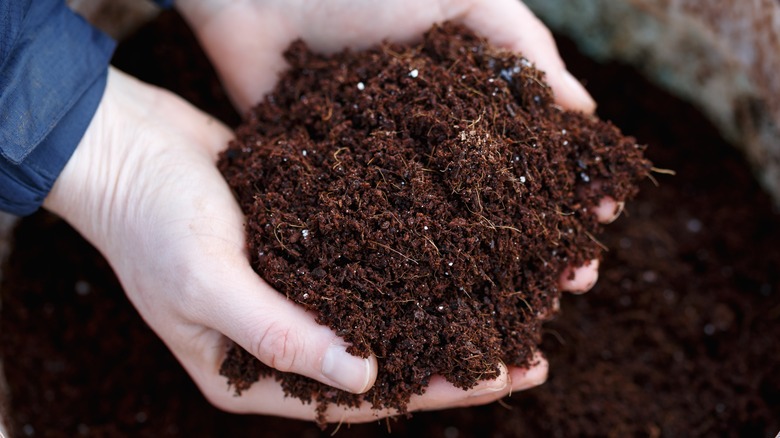
When choosing how to dispose of used cooking oil after your next meal, consider taking an eco-friendly route by tossing the cooled oil into your compost pile. Composting offers a sustainable solution for dealing with messes in the kitchen, turning waste into nutrient-rich soil for your garden. Before you proceed with this method, ensure that the oil has cleaned and cooled completely, solidifying slightly to make the process mess-free. Pouring small amounts at a time into your compost bin, mix it thoroughly with other compostable materials to avoid creating a concentrated layer of oil.
The composting process helps break down the oil and integrate it into the overall composition, providing a beneficial source of organic matter. However, it’s crucial to exercise moderation and only use small amounts of oil, as excessive amounts can disrupt the composting balance. According to McGill Composting, it’s best not to include more than a single cup of oil in your compost and to give extensive time to allow it to break down before you add more. By incorporating used cooking oil into your composting routine, you not only contribute to a greener lifestyle but also enrich your garden soil naturally.
Take the used oil to a recycling center
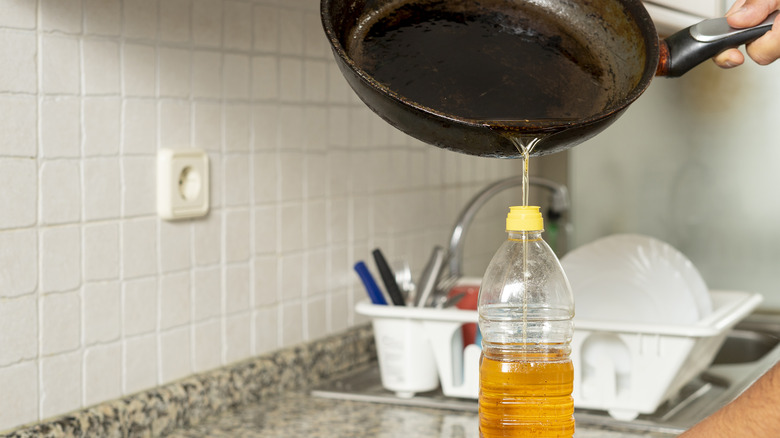
For a hassle-free and environmentally conscious way to dispose of used cooking oil or particularly large quantities that have accumulated over time, consider taking it to a recycling center. This straightforward approach eliminates the need for additional cleanup tools — all that’s required is a secure container to transport the oil to the drop-off location. Recycling centers are equipped to handle used cooking oil in an eco-friendly manner, ensuring it doesn’t end up clogging drains or harming the environment.
Depending on the recycling center, there may be certain requirements surrounding things like the type of container you can use to drop off used oil, days for accepting donations, and quantities. Some centers may also offer information to help make your drop-off go smoothly, such as suggestions for donating solid or frozen oil, so be sure to call your local center directly to get these details before you head to the donation location.
Contact local restaurants about oil collection bins
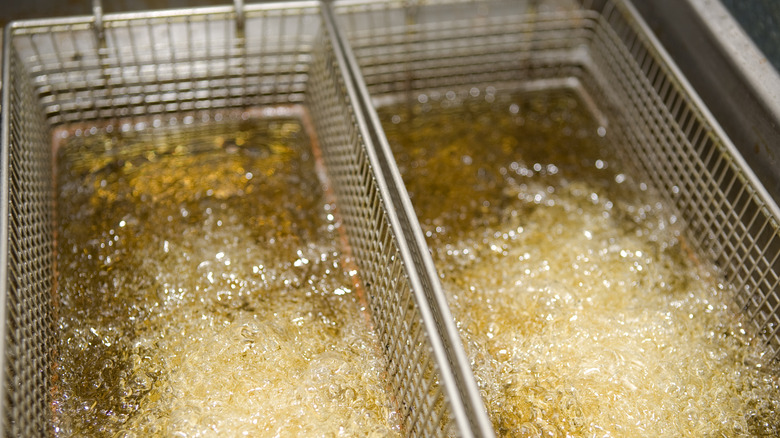
For another practical and environmentally friendly approach to getting rid of used cooking oil, try reaching out to local restaurants about using in-house collection bins to properly dispose of used cooking oil. Some eateries, especially those committed to sustainability, have contracts in place with local waste collection companies for removing and disposing of cooking oil. By connecting with these establishments, you can explore potential options for utilizing oil collection bins for your own kitchen waste. Restaurants may receive rebates for donating their used cooking oil for recycling, and inquiring about sharing these collection services could be a great way to support local businesses while also managing waste effectively.
Familiar food chains like McDonald’s and Wendy’s are committed to finding greener ways to operate, including recycling the cooking oil used in commercial fryers into repurposed diesel fuel, creating a cycle of sustainability that benefits all. Although major chains don’t typically advertise their locations as places to drop off used cooking oil, your local fast-food shop may be a franchise in which a local owner has some say over the matter. Our recommendation would be to contact the restaurant first and make sure that the quantity of oil you’re bringing is worth the hassle for all involved.



